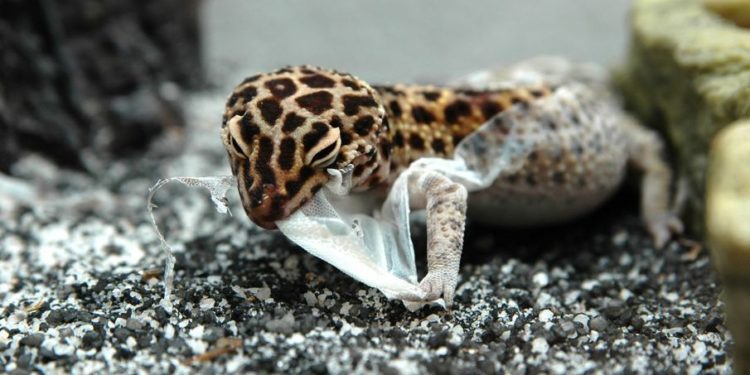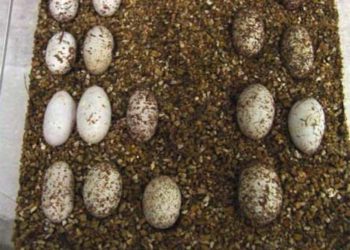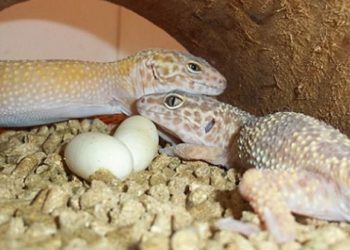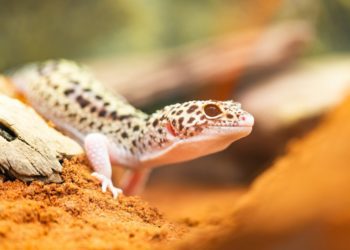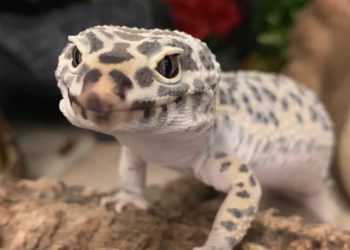Leopard gecko, like any other reptiles, shed from time to time. This reptile has become popular as pets, and the pet owners are often confused when they see their pets shedding or having any difficulty at that time. Proper knowledge about the shedding is mandatory and that will help the pets to shed in a healthy way.
Contents
Process of Leopard Gecko Shed
The skin around the toes does not shed easily and that makes a tourniquet. It later becomes tight and then it cuts the blood circulation around the toe area. This can lead to infection or even gangrene.
There are certain symptoms to understand that the gecko will start shedding. Those who have brought the gecko for the first times can be alert when they see that the skin color of the body of gecko is changing to a dull shade.
This change of coloration is a notification to show that the gecko will start shedding within a day or two. You can keep accessories inside the cage to make the process smooth and easy.
Shedding is done periodically. This process allows the skin of the gecko to grow as well as replace the damaged part of the skin.
Also Learn: Leopard Gecko Feeding
Why Leopard Geckos Experience Shedding Problems
This is a typical situation among geckos. This happens when the leopard gecko is not in good condition.
Dehydration is one condition which prevents the regular process of shedding. While dehydrated, the old skin does not easily come out. This causes the situation which is called dysecdysis, under which condition large pieces of old skin comes out.
This same situation can also happen when the gecko is stressed or affected by parasites. This is an unhealthy condition for the leopard gecko and you must take care of the reptile in such situation to make the shedding process easy.
How to treat dysecdysis?
If your leopard gecko is suffering from this above mentioned ailment, you should try your best to keep it hydrated. Keeping a bowl of water with a few paper towels soaked in it is a great way to make the hydration easy.
Most of the geckos do not drink water from the water bowl kept in their terrarium, though a few exceptions are found. So it is your duty to keep the atmosphere inside the cage moist and humid. Wet paper towels or sphagnum moss will retain moisture of the enclosed area.
Keeping the water bowl with fresh water all the time is another method which may initiate the drinking habit into the gecko. Also you can use some moisture retaining substrate like bark of oak or soil. This way the lost hydration will be back in the gecko and it will be easy for it to shed.
Shedding during stress
Giving proper hiding space inside the terrarium is a must. Some of the leopard geckos go under stress when they are about to shed. The hideout will give it ample chance and space to stay inside while shedding.

How the gecko sheds the skin?
As we have mentioned, this is a regular and natural process for the leopard gecko. Most of them shed their skin without much hassle. They usually bite the old skin and take it off where it is loose.
In case of toe skin, it becomes problematic as they cannot access that skin to bite it off. They do not usually bite the toe or licks it to make it soft. So you can offer them a bowl with warm water where they can bath and thus get enough hydrated to let the old skin loose.
You can put some mineral oil into the bowl of water, which will float on the top of the water level. When the gecko will bath into this water, the oil will enter into the space of old skin and new, thus hydrating and moisturizing the gecko. This is also a proven successful method of helping the gecko while shedding. The lubrication provided by the mineral oil makes the peeling off faster.
How to Help a Leopard Gecko Shed?
Some pet owners experience partly patchy shedding in their leopard geckos. There are flakes and patches on the body of gecko which does not come off thoroughly. There are a few suggestions for the worried pet parents.
Do not be tensed when you see such patchy skin part appearing on the body of the gecko. Shedding is a time taking process and the whole skin does not come off once. It takes more than a day and sometimes it can be 3 days long process. So you need to keep patience and keep the gecko moist to allow the old skin to shed evenly.
As already mentioned, you need to take care of the toe part of the gecko. If you see that the whole body of the gecko has been shed except the toe part, take special care or else the toe may get dislocated.
Keep the leopard gecko inside the bowl of warm water for 20 to 30 minutes. It will feel relaxed if you are beside it at that time. It will absorb the much needed water and its old skin will come off loose.
You can rub the skin off its body while it will be sitting in the water. In most cases the old skin comes off and it will not be a painful thing for the gecko. You can repeat the process in a day to see how it is improving the speed of shedding.
Also you can use a piece of cotton or clean soft cloth that is wet with mineral oil or lotion. Taking the wet piece you can rub it around the toe area or the tail part, which are difficult to be shed. This process should be continued for half an hour, and surely you will see the result.
Zoo Med Reptile Shed Aid
Zilla Reptile Health Supplies Shed-Ease Bath
Precautions to be taken while leopard gecko shedding:
There are certain areas on the body of the leopard gecko that takes time to shed. Also these parts gather parasites if the old skin is not shed and new skin has appeared on the rest part of the body. Such parts are nail and toes and sometimes area around the eyes.
In these problematic areas the shedding gets delayed due to the low blood circulation, which can cause loss of toe or tail or even eye sight. These are some sensitive areas and if you rub off the old skin to get that removed, it can cause scratches on the gecko.
You should never try to pull the dead skin off the gecko as it will only be painful for your reptile pet. The only way you can keep the gecko safe is, keeping it hydrated and moist. Along with bathing it regularly, also pay attention to the environment of the enclosure, which can be kept humid by keeping paper towels, moss and wet substrate.
Making a temporary sauna for your gecko is much helpful in such situations. A box is needed with some holes on the walls, and you can keep the gecko inside it after keeping some paper towels of moss inside the box. The box can be placed over some heat source which will release mild heat. This covered box will offer the gecko enough heat and moisture to make the old skin come out naturally.
Conclusion
Stuck shed or difficulty in shedding is caused by the low level of hydration in the body of gecko. If this situation repeats at the time of every shedding, then you must take the advice of herp vets and learn the proper way to keep the leopard gecko hydrated. Hydration is needed not only for smooth shedding but for overall good health of this reptile pet.


